There's a reason why this mango jelly recipe has over 3 million views on YouTube. This refreshing treat is as delicious as it is beautiful; not to mention easy. It's also a great party dessert as it's vegan and gluten-free. If you're want something more exciting than ice cream, this is the perfect warm weather dessert that won't melt!
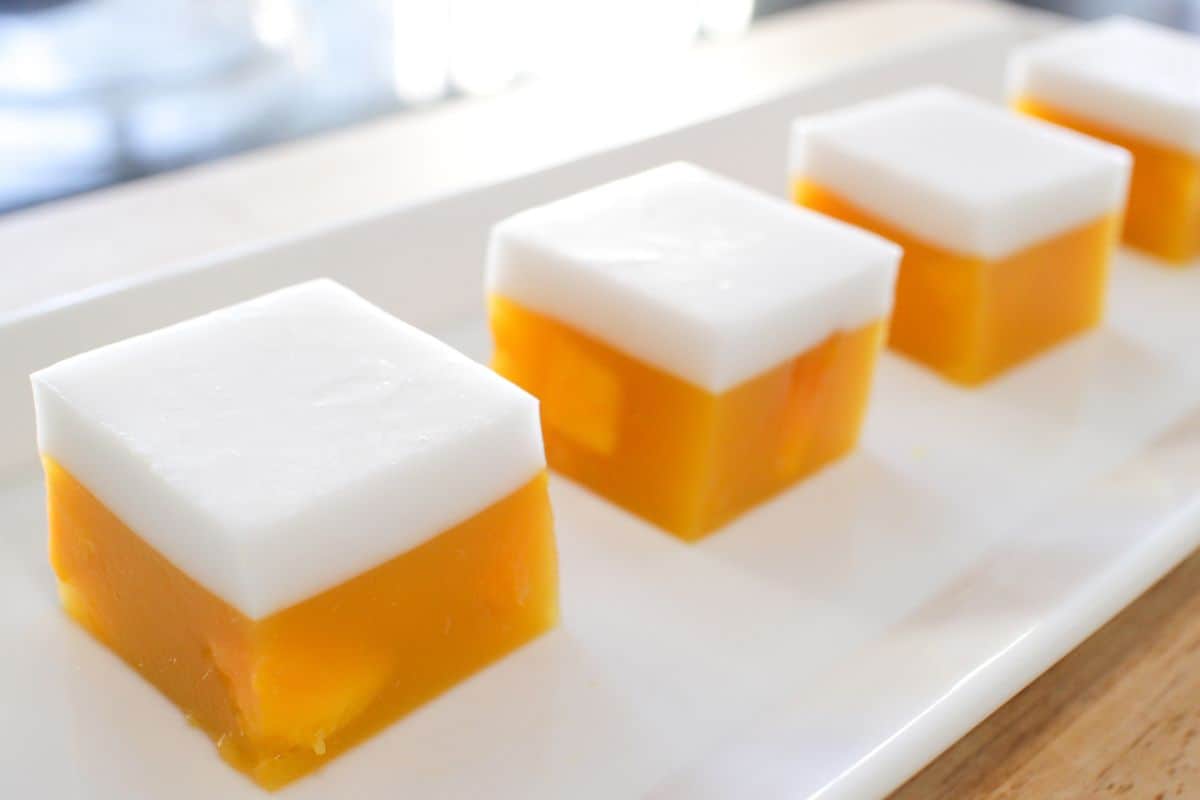
Want to save this recipe?
This mango jelly uses agar agar powder as the setting agent, not gelatin; which is why it is vegan-friendly. Agar agar jellies, or woon in Thai, are hugely popular in Thailand. Buying colourful woon from a street cart is one of the most memorable food-related highlights of my childhood.
This mango coconut version is not common however; and I came up with it myself as I wanted to make a jelly version of the famous Thai mango sticky rice. But if you want to try a traditional agar jelly recipe, try this classic: layered coconut jelly recipe.
Video: How to Make Mango Coconut Jelly
If you've never worked with agar agar jelly before, I HIGHLY recommend watching the video tutorial first to see how it works and behaves. All my recipes come with step-by-step video tutorials; and if you enjoy the show, please consider subscribing to my YouTube channel. Thank you!
Jump to:
What is agar agar?
Agar agar is the most important ingredient in this recipe, and it's crucial that you buy the right one or the recipe will not work.
Agar agar is made from seaweed, and it has the ability to gel up liquid. It's similar to what gelatin does, but the resulting jelly has a firmer, less bouncy texture - and it does not melt at room temperature, even in the hottest Thailand temperatures! This is very useful because it means agar agar jelly can be left out at room temp with no issues.
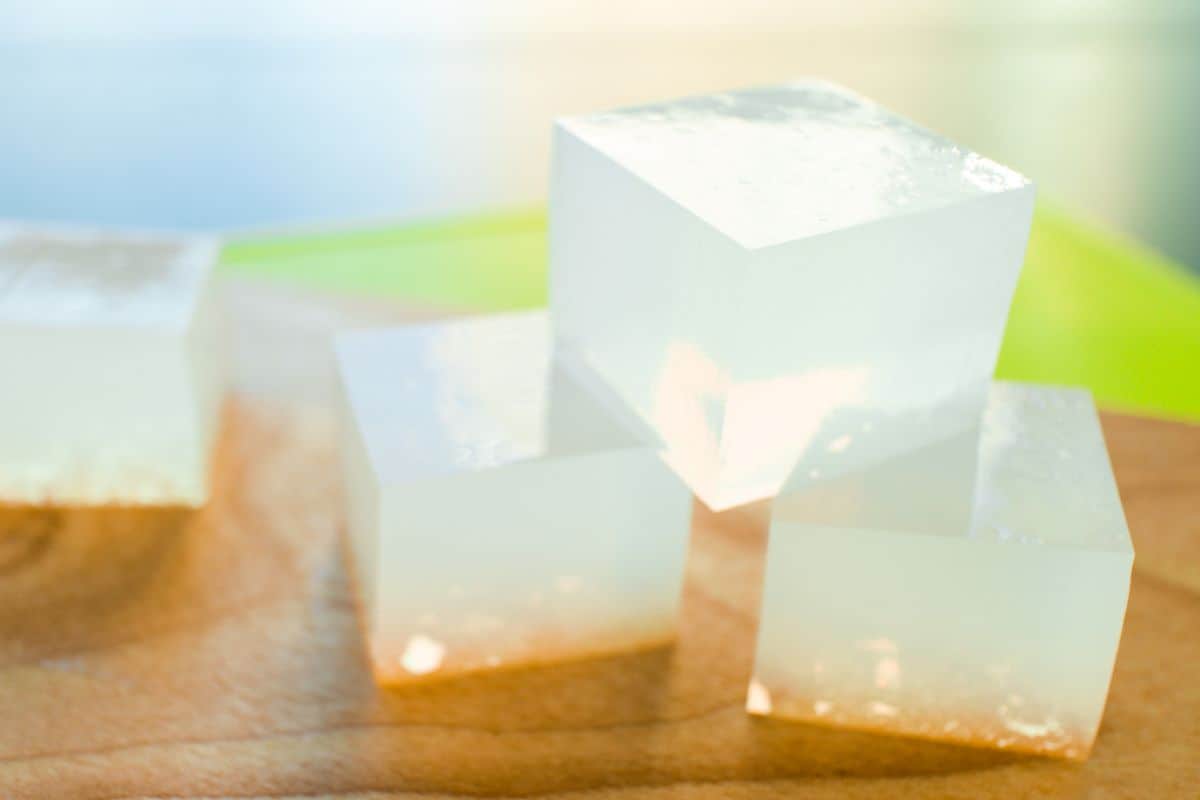
Ingredients and Notes
This recipe uses pretty simple ingredients, but there are some important things to note to make sure you have the right stuff. For amounts, see the recipe card below.
Mango Layer
- Ripe mango flesh, divided into two portions. One part is for making a puree, and the other it for cutting into cubes to give the jelly a bit of texture. For best results I recommend the ataulfo variety, also known as champagne or manila mangoes, and are the yellow teardrop shaped mangoes from the Philippines or Mexico. These are sweet, juicy, and most importantly, not fibrous. But whatever type of mango you use, make sure they are sweet, ripe and juicy for the best results. Frozen mangoes can also work, as long as they are ripe and sweet - I've had good results with the Philippine Brand frozen mangoes. Canned mango pulp will theoretically work, but good fresh mangos have better flavour.
- Orange juice. I find a little orange juice really helps bring out the flavour of the mango. You can omit this and substitute mango juice.
- Water
- Agar agar powder. Make sure you're buying pure agar agar powder with no sugar or any other ingredients added. See more on buying the right agar agar below. If measuring by volume, you need to use agar agar POWDER. If using flakes or other forms of agar agar, use the weight in grams.
- Sugar. You can add more or less of the sugar to taste, and will also depend on how sweet your mangoes are.
- Lime juice or lemon juice.
- Mint leaves, optional.
Coconut Layer
- Water
- Agar agar powder (see note above)
- Sugar
- Salt
- Coconut milk. See my post on how to choose the best coconut milk.
How to Make Mango Coconut Jelly
For the mango layer:
- In a blender, blend the mango (for the purée) and orange juice until smooth.
- In a small pot, add water and agar agar powder and stir to distribute the powder. Bring to a full boil, stirring frequently, making sure that all the agar agar powder has dissolved. Check that the powder has dissolved by using a metal spoon to scoop up the liquid and then pour it out, checking to see if there are any specks of undissolved powder stuck to the spoon.
- Add the sugar and the pureed mango to the pot and whisk until completely blended. Remove from the heat and taste; adding more sugar if you want it sweeter, and adding more lime or lemon juice to brighten up the flavour as needed.
- While hot, pour the mango mixture into your mold(s), leaving some room for the coconut layer and for the mango cubes. Add the 1-cm mango cubes into the liquid, distributing them evenly and pushing them down to make sure they are submerged. If using the mint leaves, push them into the jelly as well. Note: Agar agar jelly sets at room temperature, so work quickly; especially if you are making small ones.
- Let the jelly set at room temperature while you make the coconut layer. Don't let it become cold (don't chill it) or the top layer will not stick well.
For the coconut layer:
- In a small pot, combine water and agar agar powder and stir to distribute the powder. Bring to a full boil, stirring frequently, making sure that all the agar agar powder has dissolved. Check that the powder has dissolved by using a metal spoon to scoop up the liquid and then pour it out, checking to see if there are any specks of undissolved powder stuck to the spoon.
- Add sugar and salt; stir until dissolved. Add the coconut milk, bring it to a simmer and remove from heat.
- Check to see if the mango layer is set enough by touching the surface gently - if your finger doesn't poke through and get wet, it's ready. If it's not ready, let it set a bit longer, and meanwhile keep the coconut layer covered.
- When the mango layer is ready, check to see if the coconut layer has cooled down, and if so reheat it to a simmer. Then GENTLY pour the HOT coconut milk jelly mixture over the back of a spoon onto the mango layer (if you pour too hard it will break or cause dents in the mango layer).
- Allow to set at room temp, then refrigerate for at least a few hours until thoroughly chilled.
- Close to serving time, unmold or cut into cubes with a sharp knife and enjoy!
Tips for Advance Prep
These mango jellies are great for parties, so naturally many people wonder if they can make them in advance. Absolutely, but here are some things to know:
- Make it in advance up to 3 days ahead, but DO NOT unmold or cut the jelly until close to serving time. When agar jelly is uncontained, water will slowly seep out because it's an unstable gel. A small amount of water loss will not affect how it tastes, so if it has to sit for a couple of hours unmolded, that's totally fine. But you want to avoid it when possible; so it's best to cut or unmold as close to serving time as possible.
- Keep the jelly covered in the fridge to avoid the surface drying out or absorbing odors. On a personal note, I have kept agar agar jellies in my fridge without issues for about a week.
- If you want to give it away to people (they do make great gifts), I recommend giving it to t hem IN the mold to avoid water loss. Disposable clear cups are great for this purpose.
Buying the right agar agar: it's important!
Only buy 100% PURE agar agar powder. Some brands have sugar and/or flavouring added, and it's not always easy to tell, so you must check the ingredient list. These versions are instant mixes much like Jell-O powder, so we cannot use them in this recipe.
Agar agar also comes in non-powder forms: flakes, strings, and a few others. I highly recommend using powder because it is the easiest one to deal with. Agar flakes would be my second choice; but know that they measure differently, so you have to weigh them to get the right amount. If using bigger pieces of agar agar, such as strings, weigh it out, and then blitz it in a coffee grinder before using so that it dissolves quickly.
Below are some common options available on the market:
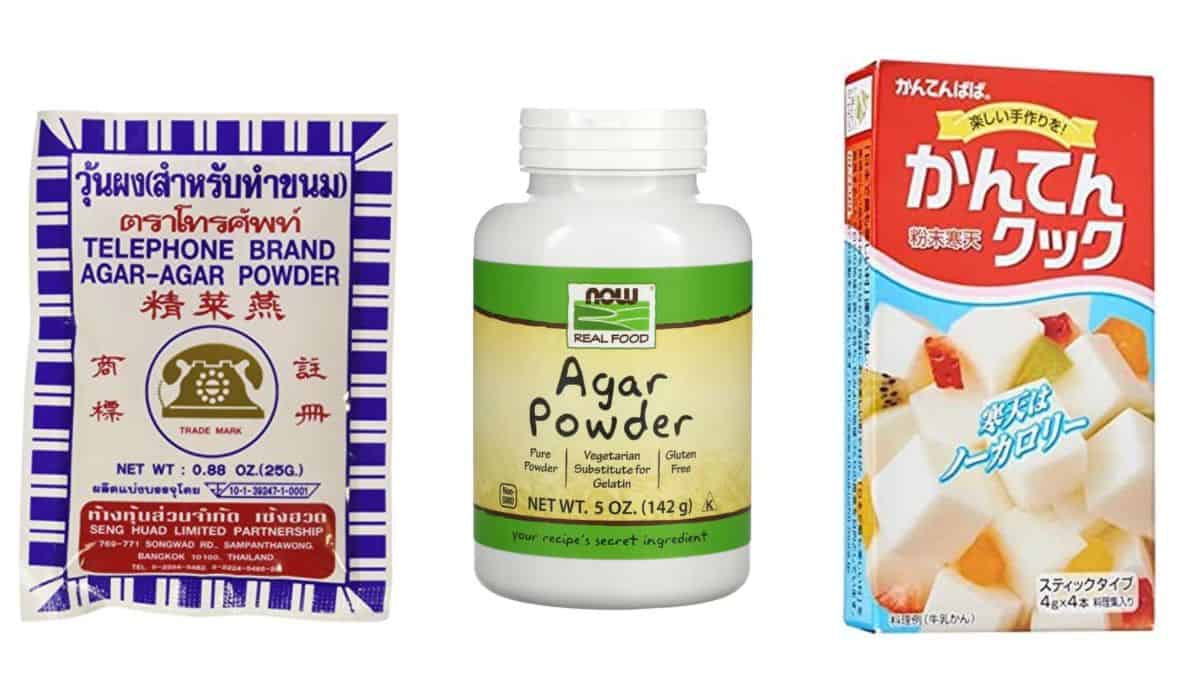
- The one on the left, Telephone Brand, is what I use. It's a Thai brand that can be found at many Southeast Asian grocery stores. It's inexpensive, a few dollars a packet, so this is ideal if you can find it.
- The NOW Real Food agar powder is what you can find at health food stores. As you can see it is advertised as a vegetarian substitute for gelatin, so naturally the price for this is much higher than the Thai one. Not ideal, but it'll work.
- If you have access to Japanese grocery stores, look for "kanten," the Japanese term for agar agar powder. The price should be a little more than the Thai one but still reasonable.
If you've got more question about agar agar, check out my in depth Agar Agar FAQ video.
Choosing the best molds for agar agar jelly
You can use whatever mold you like. I used a square pan, but you can also make individual ones using heat-resistant cups, glasses, etc. For easy unmolding, silicone or flexible plastic containers are the best, as the jelly will easily pop out with a squeeze or nudge.
If you use a hard square pan that cannot be squeezed, you can cut and serve the pieces from the pan without unmolding, like brownies, which is what's commonly done in Thailand.
Note that unlike gelatin, you cannot place the mold in hot water to dissolve the exterior slightly and flip the jelly out. Agar agar does not melt unless you used a boiling water bath, which would make this much more of a hassle and a hazard!
FAQ
Agar agar powder can be bought most inexpensively at some Asian grocery stores (especially ones that major in Thai and Vietnamese products). These would come in small packets. You can also buy it at health food stores because they are often sold as vegan alternatives to gelatin. They are also available online.
No...and yes. Gelatin behaves completely differently from agar agar, so you can apply the flavour combination to gelatin, but you cannot apply this method to gelatin.
For example, gelatin needs to be chilled in order to set, and it melts at room temp, so the bottom layer will melt if you pour a layer of hot mixture over it as we did here.
If you want to use gelatin, I recommend following instructions of a layered gelatin recipe, and change their liquids into mango and coconut flavours, rather than trying to use this recipe as a base and changing the gelatin. You'll have more success that way.
Yes, you can technically change the fruit puree to whatever you want, keeping in mind that you will need to adjust the amount of sugar to match the sweetness of the fruit. You can also change the embedded fruit pieces.
This is very common issue! To ensure that the layers stick together, the bottom layer shouldn't be too cold, and the top layer needs to be steaming hot when you pour. The heat from the second layer will melt the top of the bottom layer every so slightly so they can fuse together. If the bottom is too cold, it will cool the liquid layer down instantly.
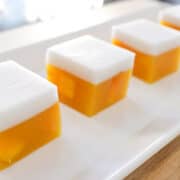
Mango Coconut Jelly Recipe
- Yield: One 8-inch square pan
Ingredients
Mango Layer
- 250 g mango flesh (for purée), roughly cubed (from about 1 ½ - 2 mangos, scant 2 cups)
- Flesh of 1 mango, 1-cm cubes
- ½ cup orange juice
- 1 ¼ cups water
- 2 teaspoon (5.2 g) agar agar powder (see note)
- ⅓ cup sugar
- Lime juice, to taste
- 15 small mint leaves, optional
Coconut Layer
- ⅔ cup water
- 1 teaspoon (2.6 g) agar agar powder (see note)
- 4 tablespoon sugar
- ⅛ teaspoon salt
- ⅔ cup coconut milk
Want to save this recipe?
Instructions
For the mango layer:
In a blender, blend the mango cubes (for the purée) and orange juice until smooth. In a small pot, add water and agar agar powder and stir to distribute the powder. Bring to a full boil, stirring frequently, making sure that all the agar agar powder has dissolved. Add sugar and mango purée and whisk until smooth. Remove from the heat and taste, adding more sugar and/or lime juice as needed.
Pour the mango mixture into a mould. You can use whatever mould you like; I used a square pan, but you can also make individual ones using cups, glasses, etc. Add the 1-cm mango cubes into the mango base, distributing the cubes evenly throughout, and pushing them down to make sure they are submerged. If desired, you can add mint leaves as well, pushing them into the mango base. Note: Agar agar jelly sets at room temperature, so work quickly especially if you are making small ones.
Let the jelly set until the surface is firm enough to pour on the next layer (if you touch it gently and your fingers are not poking through, it's ready). You CAN put it in the fridge to make it go faster, but do not let this get cold! (see note)
For the coconut layer:
In a small pot, combine water and agar agar powder and stir to distribute the powder. Bring to a full boil, stirring frequently, making sure that all the agar agar powder has dissolved. Add sugar, salt, and stir until dissolved. Add coconut milk, stir to mix and remove from heat. You can use this immediately if the mango layer has set, if the mango layer has not set, keep this mixture hot, covered, over the lowest heat setting on the stove to prevent it from setting and becoming clumpy.
Once the surface of the mango layer has set, gently pour the coconut layer over the back of a spoon on to the mango base (if you pour too hard it will break or cause dents in the mango layer). Refrigerate for a few hours until cold.
Close to serving time, cut into cubes with a sharp knife and enjoy!
Important Note on Unmolding: Do not unmold or cut agar jelly until close to serving time. When agar jelly is uncontained, water will slowly seep out because it's an unstable gel. A small amount of water loss will not affect how it tastes, and if it has to sit for a couple of hours unmolded that's fine, but you want to avoid it when possible. If you want to give it away to people, I recommend making it in clear heat-proof plastic or glass cups that you're willing to part with.
Notes
Make sure you're buying pure agar agar powder with no sugar or any other ingredients added (you'll need to check the ingredient list.) Also if measuring by volume, you'll need to use agar agar POWDER. If using flakes, use the weight in grams.
A few people have reported that their coconut layer is not sticking to the mango layer and it slides off when cut. This happens because the bottom layer has set too cold, and the top layer isn't hot enough. The layers will stick when the heat from the coconut mixture dissolves a tiny bit of the surface of the mango layer. So if the bottom layer is too cold and/or the top layer isn't hot enough, they won't stick together. See my coffee agar jelly video where I talk more about this.
More Agar Agar Jelly Recipes
Fresh mangoes not in season right now? No problem, try these jelly recipes. One for the coconut lover, and the other for the coffee lovers in your life!
More Mango Dessert Recipes
If you're here for the mangoes, definitely check out these mango dessert recipes. The mango pudding uses gelatin, so perfect if you can't find agar agar. And the mango royale is a frozen treat that is easy, yet impressive and totally indulgent.

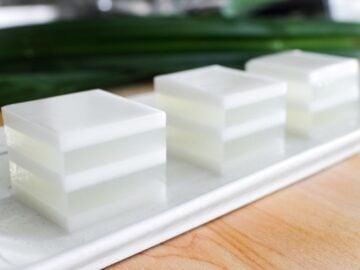
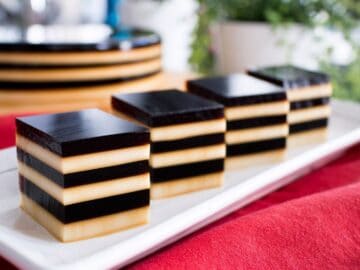

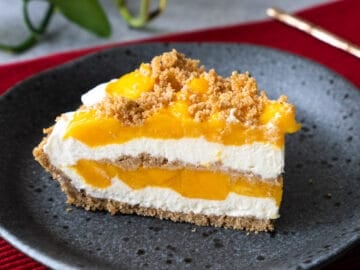


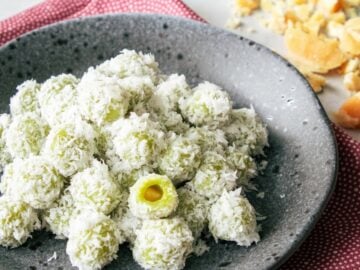
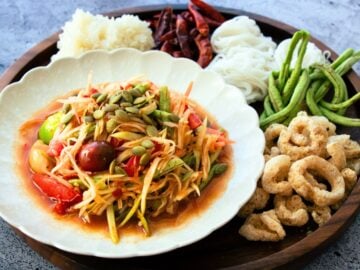

Analisa Ramoutar says
I make this recipe every year during mango season in the Caribbean and love it each time. It's so refreshing and a great way to use up those extra sweet and ripe mangos.
Chandra D Boggs says
I followed the recipe as written, but the mango layer is not setting up at all. It has coiled completely and is still liquid. Any idea why?
LauraLee says
Very light dessert and easy to make. I thought my mangoes were pretty good, but I didn’t get a lot of mango flavor or coconut flavor from either layer. My layers split also when eating. They stayed together when sliced though, and I thought I poured my coconut layer over at the right temperature with the mango layer still warm. I noticed another similar recipe called for using a fork to lightly scratch up the surface of the 1st layer to help the 2nd layer stick. I may try this next time, along with a sugar substitute to make it more keto friendly.
Larry says
What brand of agar agar powder are you using?
Pailin Chongchitnant says
I think it was Telephone brand.
LauraLee says
I used Telephone brand also.
Ceri says
How far ahead can I make these and keep in the fridge please?
Pailin Chongchitnant says
A few days ahead, but don't unmold or cut until ready to serve.
Angelina Isaacs says
I couldnt make a layer with the coconut cream liquid..just enough to drizzle on top of the mango layer. I followed the recipe diligently. Help!!
Pailin Chongchitnant says
Sorry I'm not sure I understand the problem, can you explain the issue you had in more detail?
Em says
Is it coconut milk from a can or carton?
Pailin Chongchitnant says
Always carton 🙂
Terry says
Hello,
I tried to make the coconut jelly only, and athough the taste is superb, I noticed that after being in the fridge, the coconut milk seems to separate creating a whiter layer on top and a more transparent layer on the bottom. Any idea how to prevent this?
Thank you
Pailin Chongchitnant says
That will happen naturally as coconut fat floats to the top. I wouldn't worry about it as it's just aesthetcis, but to prevent it you can add a bit of rice flour to thicken it and bind the fat to the water.
Julie says
If I use a rimmed metal cookie sheet...do I have to grease it first?
Pailin Chongchitnant says
No, these don't really stick.
Den says
can I freeze this ?
Pailin Chongchitnant says
I froze it once but with an intention to eat it half-thawed like popsicle which was really good. Never tried to thaw it all the way so not sure how that would go! Worth a try though!
Lani says
Do you use fresh Orange juice or can Orange juice instead?? And how about coconut milk?? Is it fresh or can also?? Thx b4
Sarah Rose says
If the agar-agar is in strips instead of powder then how much should I take for each layer?
Sharvinee says
Hi, can I use gelatin powder instead of agar agar powder?
Pailin Chongchitnant says
No, they are very different things.